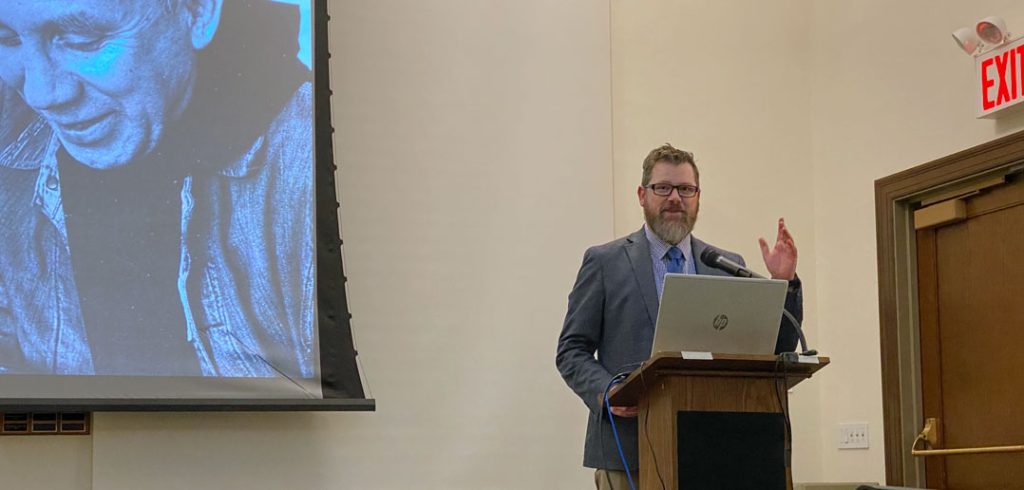Merton, an influential Catholic monk and writer, was well known for works such as No Man Is an Island and The Seven Storey Mountain, an autobiography that sold more than 1 million copies. Merton wrote more than 50 books in addition to hundreds of articles on issues such as civil rights, nonviolence, nuclear arms, and interfaith understanding. However, Merton is sometimes considered controversial, not only for his writings, but also for an affair he had when he was in his 50s.
In the summer of 1966, as he was recovering from back surgery, Merton met a nurse called “M,” in her early 20s and the two had a relationship that lasted several months.
This affair has made some Catholic leaders and authors turn away from him, while others gloss over it in their pieces about Merton, who died not long after the affair in 1968. But for Hillis, author of Man of Dialogue: Thomas Merton’s Catholic Vision, the affair is a central part of who Merton was and how we understand him.
“The reality is Merton acted irresponsibly, and without a full appreciation of the power differential that existed between him and M—none of this can and should be ignored,” said Hills in a lecture for the Curran Center for American Catholic Studies on Jan. 31. “But I do think it merits a more serious exploration. None of [the writers]examine Merton’s agonized details or thoughts about his love for M, her love for him, and the threat that this relationship posed to his vocation.”
Hillis spoke in detail about Merton’s journals from this time, while acknowledging that M’s side was never told. He explained how Merton’s passages sounded more like “the reflections of a heartstruck teenager than a 51-year-old respected monk and writer.”
“His account shows him at his most selfish and self-absorbed, but it also shows him grappling with his own evident shortcomings, with what I think is honesty and humility,” said Hills, who also spoke about Merton’s affair with students in Professor Angela O’Donnell’s class earlier that day.
Merton often wrote pieces that showed his conflicting feelings, and his love for M was no exception.
“There can be no hesitation about my position here. I have vows and I must be faithful to them,” he wrote in April 1966. “Once again it was clearer than ever that we are terribly in love, and it is the kind of love that can virtually tear you apart.”
While the affair was known before, more details and his inner conflict became clear after Merton’s journals were released 25 years after his death.
“It’s the forthrightness of his journals that continues to attract readers like me,” Hillis said. “Merton allowed himself to become an open book, warts and all.”
Merton even acknowledged this himself, stating that he planned to keep all the references to M in because he “wanted to be completely open both about my mistakes, and about my effort to make sense out of my life.”
Hillis said that this humility showed “the complexity of who he was as a human being striving to do God’s will, and often failing.”
Personal Appreciation for Merton
For both Hillis and Michael Peppard, Ph.D., professor and associate director for prestigious fellowships for the Curran Center, Merton played a central role in their careers.
“Thomas Merton is responsible for me getting my first job out of college,” Peppard said, adding that he was a finalist for two jobs after he graduated, one in Washington, D.C., at a place with a “decent salary and some cultural status,” and another teaching at a Jesuit high school.
“I had a decision to make, and what did I have on the airplane with me on the way to that final interview? I had Merton’s No Man Is an Island collection of essays,” he said. The essays, which featured passages on service, inspired him to accept the Jesuit teaching job—if it was offered.
“My final interview was with the department chair, and he asked me who my favorite theologian was. I wanted to say Merton, but I was a little bit nervous because Merton is not everyone’s cup of tea,” he recalled. But he said it anyway. “The department chair smiled very broadly and it turns out he went on to become a scholar of Merton and is currently the president of the International Thomas Merton society, so it was the right answer.”
Hillis said that Merton also helped him get his job. He had been having a “vocational crisis” when he was in his 20s and read The Seven Storey Mountain, which “is all about someone having a vocational crisis.”
“I started reading everything that Merton wrote, and in what I call ‘fit of youthful exuberance,’ I got a tattoo of a drawing that Merton did of a monk,” he said. “I mentioned this to the search committee at Bellarmine, and I think they thought, ‘we should probably get the guy that has Merton literally tattooed on his arm.’”
Merton wrote that “too often our saints are portrayed in a way that masks their humanity,” and Hillis said that it’s precisely Merton’s humanity that attracted people to him.
“Each time I got to the Abbey of Gethsemani and make a visit to Merton’s grave, I’m struck by the ways in which pilgrims venerate his burial place; marking his resting place are rosaries, prayers, guitar picks, sobriety tokens, art, and wood carvings,” Hillis said. “There are many, and I include myself among them, who understand Merton to be the kind of Christian who speaks profoundly to them, precisely because he was human.”


